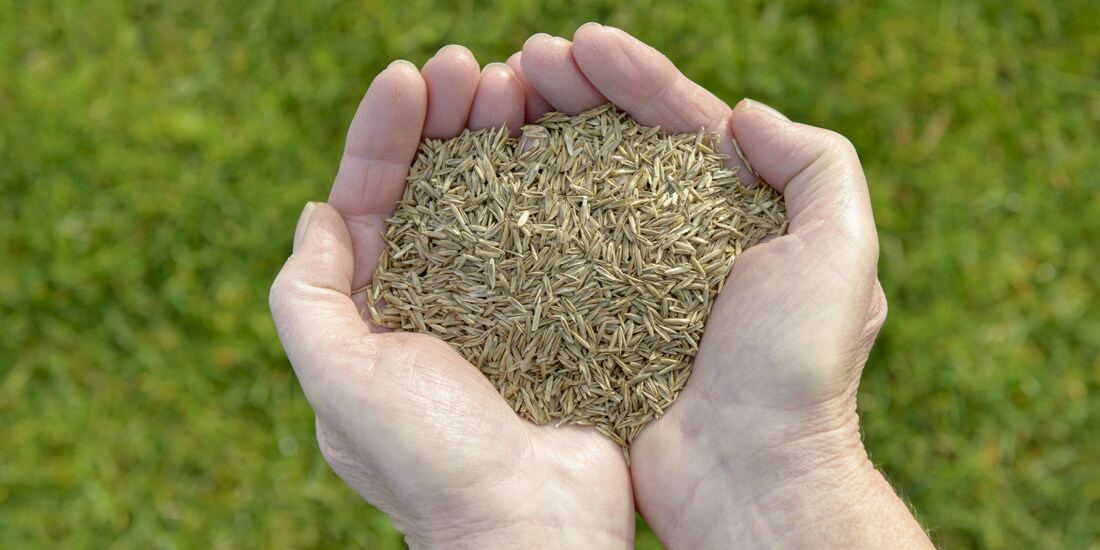Sowing grass seed in September

Every year we get asked the same question ‘Can I sow grass seed in September?’ And every year we have the same answer – yes!
September may seem like an odd time to be undertaking any gardening work, never mind considering whether or not you should sow grass seed. However, sowing grass seed in September has many benefits since sowing in autumn is a great time to plant grass seed, and will give you a head start on your spring / summer lawn.
Can I sow grass seed in September?
Yes, September temperatures are still ideal for germination, hitting highs of 8-10 degrees and above.
Generally, in the UK, in September, there is usually some rain to keep your soil and new seeds moist. This means there is less need for you to have the hose out or the sprinkler on standby!
Remove weeds when you sow grass seed in September!
There is also less chance of weeds and pests invading your new lawn due to slightly milder temperatures. A lot of bird species also begin to migrate, preventing your just-sown seed from being gobbled up.
Can I overseed in autumn?
You can also overseed or sow a new lawn from scratch in September. But be sure to always consult a two-week weather forecast prior to sowing. This is to ensure temperatures are 8-10 degrees and above, with no sudden storms forecast.
You should make sure you follow all the necessary steps we have outlined below to make sure your September sowing is a resounding success.
Overseeding your existing lawn in autumn
- Scarify your lawn to remove moss, weeds and built-up thatch and loosen up the top layer of soil.
- Apply our SLOW RELEASE: Autumn / Winter feed at a rate of 35g per m2 by hand when wearing a glove or by using a spreader. This will help to keep your new grass healthy and free from frost damage and disease going into the colder months.
- Alternatively, you can use our Make it Strong liquid fertiliser to feed your lawn quickly. This is beneficial if you've left fertilising late in the season or want to apply a fast-acting lawn food.
- Water in the fertiliser until it is fully dissolved (this can take up to 48 hours). Once it is dissolved, you can overseed.
- Overseed at a rate of 35g per m2 by hand or by using a spreader.
- Rake the seed in so it is in amongst the soil. You can then firm it down by foot to improve seed-to-soil contact.
- Water the area immediately after sowing, and continue to water it daily for the first six weeks. You can avoid doing this if there is prolonged rainfall.
- Remember to clear away any fallen leaves while your lawn is established.
- Mow the lawn when it is established around the 6-week mark on the highest setting on your mower. You can read more on the last grass cut of the season guide.
Sowing a new lawn from scratch in September
- Dig your soil over to a depth of 20-25cm then rake – this is to help achieve a fine, level and friable seedbed.
- Add topsoil to the area if you believe the soil to be of poor quality or to level out dips in the lawn.
- Leave the area to cultivate for 10-14 days, removing any weeds that may pop up due to disturbance in the soil. You can do this by hand or by using a weedkiller.
- Apply our QUICK RELEASE: Pre-Seed feed at a rate of 70g per m2 by hand when wearing a glove, or by using a spreader; this will help accelerate the growth of your new lawn.
- Water the fertiliser in until it is fully dissolved (this can take up to 48 hours); once it is dissolved, you can sow your seed.
- Sow your chosen seed at a rate of 50g per m2 by hand or by using a spreader.
- Rake the seed in so that it is among the soil and firm down by foot to improve seed-to-soil contact.
- Water the area immediately after sowing and continue to water it daily for the first six weeks after sowing. Avoid doing this if there is prolonged rainfall.
- Mow the lawn when it is established around the 6-week mark on the highest setting on your mower.
- Consider applying our SLOW RELEASE: Autumn / Winter feed to protect your lawn from frost and winter-borne disease.
Below, we have listed some helpful articles to guide you through the process of preparing your lawn for winter and autumn/winter lawn care to ensure your lawn is ready for the cold months ahead: